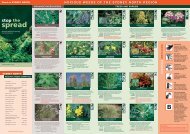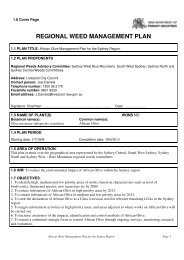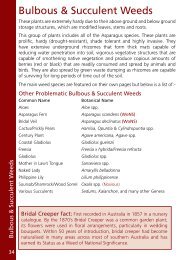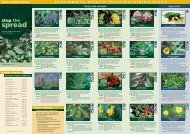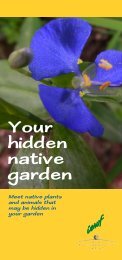“Garden Escapes” education booklet - Sydney Weeds Committees
“Garden Escapes” education booklet - Sydney Weeds Committees
“Garden Escapes” education booklet - Sydney Weeds Committees
You also want an ePaper? Increase the reach of your titles
YUMPU automatically turns print PDFs into web optimized ePapers that Google loves.
26<br />
Lippia<br />
Phyla canescens<br />
Family:<br />
Origin:<br />
Habit:<br />
Leaves:<br />
Flowers:<br />
Fruit:<br />
Roots:<br />
Dispersal:<br />
Control:<br />
Introduced as a lawn species and once used<br />
to stabilise soil on banks of irrigation canals<br />
and around weirs. Overruns native vegetation,<br />
and is capable of suppressing the growth of<br />
Verbenaceae neighbouring plants.<br />
Americas from California to Argentina and Chile<br />
Hardy, mat forming, perennial herb with stems that root at nodes.<br />
Ovate, with blunt short teeth; 0.5-3cm long, 2-10mm wide,<br />
without hairs or with short dense hairs; leaf stalk absent or short.<br />
Infl orescence a dense short cylindrical to globe-shaped spike of<br />
tubular fl owers, on a stalk which is 1-6.5cm long and usually<br />
much longer than leaves at the stalk base; petals usually lilac or<br />
pink. Flower tubes 2-3mm long. Spring to late autumn.<br />
Ellpisoid to globose, 1.5-2mm long.<br />
Dense and mat forming.<br />
Seed and fragments spread by water, humans, contaminated<br />
soil (earthmoving equipment, car tyres etc) and garden<br />
refuse dumping.<br />
Foliar spray, pasture improvement techniques.



